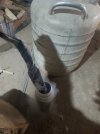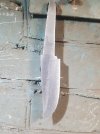Well one of my mentors taught me to stress relieve material before heat treating so i generally do





I have never heard that a stress relief was necessary for air hardened steel. I just used it as is. I just bent and impacted thinner 3V and dosed it with acid and it seemed fine. Same as the thinner blades from the last HT.
From knifesteelnerds.com
“
I don’t think so... I’ve done it the same way in the past as you describedI get that. If we were talking heavy warping and perhaps a random crack it would be something to look into but these were just profiled and from what I understand are not known for cracks and I think something else is wrong.
How much solvent and dry ice do people use normally? I used about a half gallon if solvent in a large cooler and it was about 3/4-1" deep. I had probably about 8lbs or so of dry ice left by the time I added it to the solvent and chopped it up the best I could. The gave me a 10lb solid cube and I wasn't thinking and didn't chop it up before adding it so I just chopped it the best I could and stirred it up. These were both close to 3/8" thick. Would being in a shallow bath with floating chunks of dry ice lead to uneven cooling and be enough to form cracks? If that were the case it would make sense that the thinner stock would be fine.



